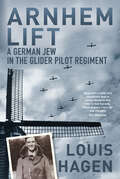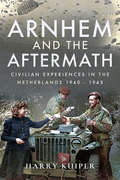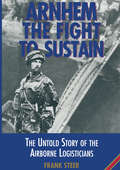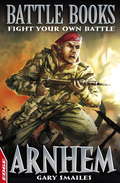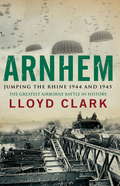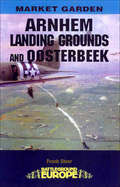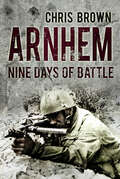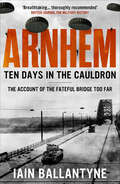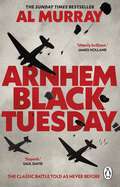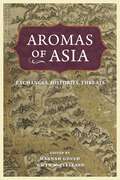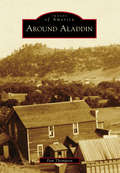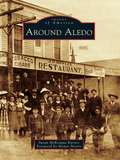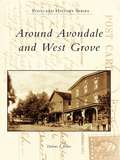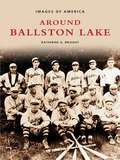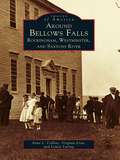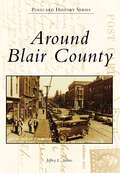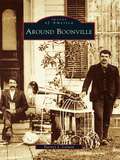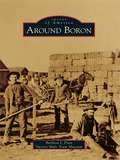- Table View
- List View
Arnhem Lift: A German Jew in the Glider Pilot Regiment
by Louis HagenOf the 10,000 men who landed at Arnhem, over nine days 1,400 were killed and more than 6,000 – about a third of them wounded – were captured. It was a bloody disaster. The remarkable Louis Hagen, an ‘enemy alien’ who had escaped to England having been imprisoned and tortured in a Nazi concentration camp as a boy just a few years earlier, was one of the minority who made it back. What makes this book so unforgettable is not only the breathtaking drama of the story itself, it is the unmistakable talent of the writer. The narrative was first published anonymously in 1945.45 years later at a dinner party in Germany, Louis Hagen met Major Winrich Behr, Adjutant to Field Marshal Model at Arnhem. Louis added his side of the story to add even more insight to the original work.
Arnhem and the Aftermath: Civilian Experiences in the Netherlands 1940-1945
by Harry KuiperWar is far more than a series of military victories and defeats. Civilians always are the biggest victims and there are often staggering imbalances between casualties on the frontlines, and those behind; between the victims and the aggressors. According to recent figures, The Second World War saw the deaths of an estimated 72 million people worldwide, two thirds of whom were civilians. Wars also have serious social, economic and human consequences. They may defeat politicians and aggressive politics, but it is communities who pay the price. In 1939 one European country after another suffered defeat, which later resulted in enormous social and economic degradations of the communities involved. The failure of Operation Market Garden in 1944 resulted in yet another tragedy for the Dutch and one that would have far deeper social consequences than those before it. After the Allies were defeated, the Nazis terrorised the local Dutch populace and the V2 rockets fired immediately from their Dutch launch sites resulted in over 9,000 casualties in the UK.Arnhem and the Aftermath begins and ends in Arnhem, in 1940 and 1945 respectively. It focuses on the experiences of the civilians in those mournful years, against a back-drop of all three airborne operations in the Netherlands, in which both German and Allied forces were involved.
Arnhem the Fight to Sustain: The Untold Story of the Airborne Logisticians
by Frank SteerOn the ground the airborne logisticians at the battle of Arnhem fought to the bitter end, indistinguishable from their paratroop comrades. In the air, their deeds and sacrifice were shining examples of duty done under the most desperate circumstances. Witness the account of Flight Lieutenant H J King, navigator of Dakota KG 374 of 271 squadron RAF, Down Ampney:These men were not volunteers like aircrew. They received no flyingpay, yet were, without doubt, superb in their fulfilment of duty even though KG 374 was burning for the whole period over the dropping zone. Arnhem—The Fight To Sustain tells the stirring story of the men and the methods employed in sustaining 1st Airborne Division. It is the first account of forming corps of today's Royal Logistic Corps in action together.Following extensive research the story draws heavily on contemporary documents and eyewitness accounts and is lavishly illustrated.
Arnhem: Fight Your Own Battle
by Gary Smailes David CousensTake up your weapons and prepare to fight your own battle in these all-action, interactive adventures, in which you take part in epic battles from throughout history.It is 1944 and Europe is still in the iron claw of Nazi German forces. In an attempt to end the war, British leaders have a plan to send elite troops deep behind German defences to capture key targets, including bridges. You are a Lieutenant in the 2nd Parachute Battalion. You must command your men forward through enemy territory and reach the bridge in the Dutch town of Arnhem. You must hold the bridge at any cost...
Arnhem: Fight Your Own Battle (EDGE: Battle Books #2)
by Gary SmailesTake up your weapons and prepare to fight your own battle in these all-action, interactive adventures, in which you take part in epic battles from throughout history.It is 1944 and Europe is still in the iron claw of Nazi German forces. In an attempt to end the war, British leaders have a plan to send elite troops deep behind German defences to capture key targets, including bridges. You are a Lieutenant in the 2nd Parachute Battalion. You must command your men forward through enemy territory and reach the bridge in the Dutch town of Arnhem. You must hold the bridge at any cost...
Arnhem: Jumping the Rhine 1944 & 1945
by Lloyd ClarkAn insightful and gripping account of the largest airborne operation in history. In September 1944, the river Rhine was a serious barrier to the advancing Allied armies in the West who were intent on charging Berlin and ending the war. Field Marshal Bernard Montgomery decided to utilise the First Allied Airborne Army consisting of British, American and Polish troops. Codenamed Operation Market Garden, 40,000 paratroopers were dropped behind enemy lines while ground forces linked to relieve them. But, due to bad weather and German resistance, the operation failed. In March 1945, asecond attempt was planned: Operation Varsity Plunder. This time the plan worked. Despite extremely heavy fighting, they cracked the German line.
Arnhem: Jumping the Rhine 1944 & 1945
by Lloyd ClarkAn insightful and gripping account of the largest airborne operation in history. In September 1944, the river Rhine was a serious barrier to the advancing Allied armies in the West who were intent on charging Berlin and ending the war. Field Marshal Bernard Montgomery decided to utilise the First Allied Airborne Army consisting of British, American and Polish troops. Codenamed Operation Market Garden, 40,000 paratroopers were dropped behind enemy lines while ground forces linked to relieve them. But, due to bad weather and German resistance, the operation failed. In March 1945, asecond attempt was planned: Operation Varsity Plunder. This time the plan worked. Despite extremely heavy fighting, they cracked the German line.
Arnhem: Landing Grounds And Oosterbeek (Battleground Europe)
by Frank SteerThis is the latest in the well-respected Battleground series of books, and covers a number of aspects of the battle of Arnhem. It concentrates on the landings and the desperate and legendary battle fought by the remnants of 1st Airborne Division in the town of Oosterbeek. The book relies on both historical knowledge and anecdotes from veterans to bring to life the events of those fateful days of late September 1944.Having set the strategic scene in the opening chapter, the guide suggests four separate tours around the area, one on foot and the others requiring a car. They can all be completed in a full day, but are structured in such a way that visitors can make their own choice of how and where to visit. For a clear, concise and accurate account of the Arnhem-Oosterbeek battlefield this excellent addition to our Battleground series is unlikely to be beaten.
Arnhem: Nine Days of Battle
by Chris BrownThe greatest airborne operation in history commenced on 17 September 1944. Nine days later nearly four out five of the British 1st Airborne Division and their Polish comrades would be killed, wounded or captured as Germany secured her last great battlefield victory of the war. The ferocious and gallant actions in Arnhem and Oosterbeek have fascinated historians and students ever since. Drawing extensively on eye-witness experience and unit diaries, and providing a detailed tactical and technical analysis of the arms, equipment and practices of the day, Arnhem: Nine Days of Battle provides a fascinating day-on-day account of one of the most iconic actions of the Second World War. Supported by battle maps, timelines, troop diagrams as well as touring guides – this is the perfect companion for the armchair historian or the intrepid battlefield traveller.
Arnhem: Ten Days in the Cauldron
by Iain BallantyneThe account of the fateful bridge too far…‘It was a bridge too far and perhaps the whole plan was doomed to failure from the start, but we had to try, didn’t we?’17 September 1944: 30,000 airborne soldiers prepare to drop 64 miles behind enemy lines into Nazi-occupied Holland; tens of thousands of ground troops race down Hell’s Highway in tanks and armoured cars, trucks and half-tracks to link up with them. The goal – to secure eight bridges across the Rhine and end the war by Christmas. Ten days later, over 15,000 of these soldiers have died, 6,000 have been taken prisoner.Operation Market Garden was the daring plan to stage a coup de main in occupied territory, gain control of those bridges, and obtain a direct route into Hitler’s Germany. But the operation failed and the allied forces suffered a brutal military defeat.In the 75 years since, tactics have been analysed and blame has been placed, but the heart of Arnhem’s story lies in the selflessness and bravery of those troops that fought, the courage and resilience of the civilians caught up in confrontation, and the pure determination to fight for their lives and their freedom. This is the story of ordinary people caught up in extraordinary events.In Ballantyne’s Arnhem, we go into battle with not only the famous commanders in the thick of the action, but also with all those whose fates were determined by their decisions. Based on first-hand interviews, military records, and diaries, we witness the confusion and mayhem of war – from the horrific and devastating to the surreal and mundane. But most of all, we witness the self-sacrifice and valour of the men who gave their lives to liberate strangers in a foreign country.Praise for Arnhem: Ten Days in the Cauldron‘Reminiscent of Stephen Ambrose at his best… some remarkable stories, which Ballantyne neatly dovetails into a rolling epic’ Dr Harry Bennett, University of Plymouth‘Breath-taking… I thoroughly enjoyed reading this account of Arnhem, adding, if you like, a trench-level perspective to those other accounts written from more senior, and sometimes more detached, points of view. Thoroughly recommended’ British Journal for Military History
Arnhem: The Classic World War II Battle Told As Never Before
by Al MurrayDiscover the Sunday Times bestseller and incredible true story behind the most catastrophic 24-hours the British military faced in World War II from the bestselling author.‘Utterly brilliant... this book really is the last word on the Battle of Arnhem’ James Holland’Superb... A military historian of originality and insight to compare with the best’ Saul David_________The Battle of Arnhem is one of the best-known stories in British military history: a daring but doomed attempt to secure a vital bridgehead across the Rhine in order to end the war before Christmas 1944.It is always written about, with the benefit of unerring 20/20 hindsight, as being destined to fail, but the men who fought there, men of military legend, didn't know that that was to be their fate.Now, in Arnhem: Black Tuesday, Al Murray focuses on the events of one day as they happened through the eyes of the British participants, without bringing any knowledge of what would happen tomorrow to bear, offering a very different perspective on a familiar narrative.Some things went right and a great many more went wrong, but recounting them in this way allows the reader to understand for the first time how certain decisions were taken in the moment and how opportunities were squandered.Al Murray has always been obsessed by this legendary battle, and in Arnhem: Black Tuesday he showcases all of his knowledge, interpretation and enthusiasm to bear to tell the story of one of history’s great heroic failures differently for the first time._________Praise for Arnhem: Black Tuesday:‘Original and insightful’ Telegraph'A revelation.. This is Arnhem unplugged. By confining himself to men in and around Arnhem on that Tuesday, Murray achieves something special' The Times
Arnold Arboretum (Images of America)
by Lisa E. PearsonEstablished in 1872 and designed in collaboration with landscape architect Frederick Law Olmsted, the Arnold Arboretum is a National Historic Landmark. Founded as a partnership between the City of Boston and Harvard University, the Arnold Arboretum is a unique blend of a respected research institution and beloved public park in Boston's Emerald Necklace. Occupying 281 acres, its living collection of trees, shrubs, and woody vines is recognized as one of the most comprehensive and best documented of its kind in the world. Its lilac collection is a springtime favorite of visitors, along with the magnificent rhododendrons, and in the fall, trees from maples to dawn redwoods provide a wonderful display of color. The living collection is supported by curatorial documentation, a herbarium, library and archival holdings, and a state-of-the-art research center. These facilities and holdings provide the basis for research and education of visitors, students, and scholars from around the world.
Arnold Palmer: A Tribute to an American Icon
by David Fischer David ArethaBeginning with his triumph in the 1958 Masters, Arnold Palmer took the nation by storm with his small-town charm, "go for broke” style, and Sunday comebacks. "You finally had someone who had this charisma,” said Tiger Woods. "Everyone got hooked to the game of golf via TV because of Arnold.”Palmer won 43 PGA Tour events in the 1960s, became the sports world’s greatest pitchman, and hobnobbed with bigwigs like Bob Hope and multiple presidents. He even guest-hosted The Tonight Show. A licensed pilot, he flew jet airplanes across the globe. As a philanthropist, he founded Arnold Palmer Medical Center, the largest facility in the country dedicated to the care of women and children.In Arnold Palmer: A Tribute to an American Icon, authors David Fischer and David Aretha relive Palmer’s thrilling championship moments while capturing his personal charms: his warmth, humor, and candor. Rarely seen photographs and memorabilia bring his story to life.Golfer Raymond Floyd may have summed it up best when he said that Palmer "set the standard for how superstars in every sport ought to be, in the way he has always signed autographs, in the way he has always made time for everyone . . . . And man, could he play the game.”
Aro, el guerrero lobo (Historia Incógnita)
by Augusto Rodríguez de la RúaEl destino del mundo se dirime en Iberia, los romanos y los cartagineses pugnan por el control del Mediterráneo. Pero el Imperio es insaciable y necesita el dominio de la península, Aro el guerrero lobo, acaudillará a los vacceos para oponerse a las todopoderosas legiones romanas. Año 210 a. C. Aro mira al futuro con optimismo: la cosecha vuelve a ser abundante por primera vez en mucho tiempo, sus rebaños son cada vez más grandes y su esposa Coriaca está a punto de parir a su primer hijo. Pero pronto reciben noticias preocupantes: los romanos, en su guerra contra los cartagineses, han desembarcado en la tierra de los ilergetas. Aro presiente que el bando vencedor no volverá a su país. Y teme que, al contrario, quieran conquistar toda la tierra que tienen por delante. Sus presagios se cumplen cuando Roma vence a Cartago y decide adueñarse de Hispania. Pasarán años antes de que se acerquen al territorio vacceo, pero finalmente los carpetanos, que viven al sur de los vacceos, les piden ayuda para defenderse de las legiones de Roma. La ambición de Coriaca, un regalo de su hermano Docio y los sueños proféticos de un anciano druida obligarán a Aro a ponerse al frente de los vacceos y acudir a la llamada de Hilerno, rey de los carpetanos. ¿Cumplirá Aro la profecía de los druidas y salvará a su pueblo?
Aromas of Asia: Exchanges, Histories, Threats (Perspectives on Sensory History)
by Hannah Gould and Gwyn McClellandA uniquely powerful marker of ethnic, gender, and class identities, scent can also overwhelm previously constructed boundaries and transform social-sensory realities within contexts of environmental degradation, pathogen outbreaks, and racial politics. This innovative multidisciplinary volume critically examines olfaction in Asian societies with the goal of unlocking its full potential as an analytical frame and lived phenomenon.Featuring contributions from international scholars with deep knowledge of the region, this volume conceptualizes Asia and its borders as a dynamic, transnationally connected space of olfactory exchange. Using examples such as trade along the Silk Road; the diffusion of dharmic religious traditions out of South Asia; the waves of invasion, colonization, and forced relocation that shaped the history of the continent; and other “sensory highways” of contact, the contributors break down essentializing olfactory tropes and reveal how scent functions as a category of social and moral boundary-marking and boundary-breaching within, between, and beyond Asian societies. Smell shapes individual, collective, and state-based memory, as well as discourses about heritage and power. As such, it suggests a pervasive and powerful intimacy that contributes to our understanding of the human condition, mobility, and interconnection.In addition to the editors, the contributors to this volume include Khoo Gaik Cheng, Jean Duruz, Qian Jia, Shivani Kapoor, Adam Liebman, Lorenzo Marinucci, Peter Romaskiewicz, Saki Tanada, Aubrey Tang, and Ruth E. Toulson.
Around Aladdin (Images of America)
by Pam ThompsonAladdin is located in northeast Crook County, in the far northeast corner of Wyoming. The town, the lowest settlement in the state at 3,749 feet, is surrounded by vast plains of waving grass, wooded mountains, and rolling hills. Coal mining brought the early families to the area and has since formed the histories and memories of the people who came and worked to build farms and ranches. Descendents of many of the original settlers still reside in the community, working and raising their families. Around Aladdin contains the stories and memories of those that came to make this part of Wyoming a place to call home for a long, long time.
Around Aledo (Images of America)
by Homer Norris Susan Mckeague KarnesIn the mid-19th century, a few hardy settlers of European descent carved out farms in the Clear Fork Valley of present-day Parker County, attracted by the area's springs, tributaries, and a burgeoning market in nearby Fort Worth. For centuries, Comanche and Kiowa had inhabited the land, and a period of dramatic conflict ensued, exacerbated by the Civil War absence of able-bodied husbands and sons. By 1880, ranches and settlements flourished, aided by the Fort Worth-Yuma cattle trail and a Texas and Pacific Railway line connecting Fort Worth to the county seat of Weatherford. As the first mail stop in the newly formed county, Aledo was briefly dubbed Parker Station before having its name changed in 1882--a bow to a railroad engineer's Illinois hometown. Today segments of Bankhead Highway, the nation's first paved transcontinental highway, wind around Aledo, the Annettas, Willow Park, and Hudson Oaks, thriving communities that offer a pastoral lifestyle minutes from the urban amenities of the Fort Worth-Dallas Metroplex. Mere fragments remain of Newburg, Prairie Hill, Willow Springs, and other old settlements, visible only to old-timers and lost to living memory.
Around Avondale and West Grove (Postcard History Series)
by Dolores I. RoweChester County was one of the three original counties established by William Penn, giving it a long history of settlement and growth. Around Avondale and West Grove features historic postcards from Avondale, Baker's Station, Chatham, West Grove, and the surrounding area. Jennersville, located in Penn Township, has close ties to the rose industry begun in London Grove. This area was a rich agricultural district that had many nurseries (including one of world renown), creameries, mushroom farms, horse farms, an experimental farm for research, and other agricultural ventures. White Clay Creek, now a federally designated wild and scenic river, supported many mills. Granite and marble supplied the quarry industry. The township's location along the main highways between Lancaster, Wilmington, Philadelphia, and Baltimore made it an important route for commerce.
Around Ballston Lake (Images of America)
by Katherine Q. BriaddyBallston is a scenic town located in Saratoga County, with a history that is as long as it is interesting. Katherine Q. Briaddy takes us along on a journey into Ballston's past, providing insight into the lives of Ballston's early residents. Encompassing the years between the late 1700s and the present, the photographs within depict the area as it has changed and evolved over the years. As you peruse through the over 200 images, you will visit Ballston's recreational draws, such as Ballston Lake and Forest Park. You will see the houses that survived the British and Indian invasion of 1780, and the trolleys and railroads that came with the advance of technology. You will tour through the mansions, manors, and humble farms of Ballston's residents; you will see interpretations of the town's landmarks by local artists. You will observe the way life used to be for those who chose to call Ballston home.
Around Bellows Falls: Rockingham, Westminster and Saxtons River
by Louise Luring Virginia Lisai Anne L. CollinsWith more than two hundred vintage photographs, Around Bellows Falls: Rockingham, Westminster, and Saxtons River explores the fascinating history of these southern Vermont communities. Located along the Connecticut River, Rockingham-the township that includes both Bellows Falls and Saxtons River-was chartered in 1752. Westminster, one of Vermont's oldest towns, was granted in 1736 as Township No. 1.Around Bellows Falls: Rockingham, Westminster, and Saxtons River chronicles the history of these communities up to the mid-twentieth century with photographs of historic homes, businesses, people, and well-known landmarks. In addition to views of the fantastic beauty of the area, this volume includes photographs of Vermont's oldest public building, the Rockingham Meetinghouse (built in 1787), and the Bellows Falls home of Hetty Green, the infamous "witch of Wall Street." Westminster's Cumberland County Court was the location of not only the Westminster Massacre but also the meeting that declared Vermont as a free and independent republic in 1777. Also included are vintage photographs of the scenic village of Saxtons River (named on the National Register of Historic Places), which once had a strong mill industry that took advantage of three falls along the river.
Around Binghamton (Images of Modern America)
by Jim MaggioreThe Greater Binghamton area’s undulating history mirrors that of its terrain. The area has evolved from a transportation center to a hub of manufacturing and technology and, with the expansion of Binghamton University and SUNY Broome Community College, a growing center of erudition. First, canal boats and trains dominated the landscape, then, cigars were produced in abundance, followed by shoes, simulators, and computers. Now, with Binghamton University expanding into downtown, student housing, breweries, and eateries fill Binghamton’s streets. The area has earned the monikers “Parlor City,” “Carousel Capital of the World,” “Sports Mecca,” and the “City of Festivals.” Binghamton’s cultural legacy is rich; besides being the home of professional baseball, bicycling, golf, hockey, running, and tennis, Binghamton’s annual celebrations have included Mural Fest, July Fest, Spiedie Fest, and Luma Fest.
Around Blair County
by Jeffrey L. AdamsSituated in the very heart of Pennsylvania, Blair County is bounded on the west by the formidable Allegheny Mountains. It was this natural barrier that stalled westward migration and encouraged early settlers to farm its lush, fertile valleys prior to the American Revolution. Carved out of Bedford and Huntingdon Counties in 1846, Blair County was home to many iron furnaces in the 1800s and was on the chosen path of the great Pennsylvania Canal. However, it was the Pennsylvania Railroad that utilized Blair County as its base of operations, thus creating a unique transportation-based economy. Today, Blair County is bisected by Interstate 99. This highway, which parallels a great Native American path, provides travelers with views of some of the loftiest mountains and the most picturesque scenery of the state.
Around Boonville (Images of America)
by Harney J. CorwinNestled in the Black River valley with the Tug Hill Plateau to the east and the Adirondack Mountains to the west, Boonville traces its origin to the failure of a grand investment scheme. In the mid-1790s, Gerrit Boon, agent for the Holland Land Company, purchased vast acreage in northern New York, hoping to establish a plantation for the production of maple sugar. When that enterprise collapsed, Boon founded a settlement in the remote wilderness. Adopting a paternalistic stance, he attracted settlers by extending financial assistance to farmers, artisans, and tradesmen. The village soon prospered, and dairy farming became the dominant industry. With the arrival of a canal and railroad in the mid-1800s, Boonville expanded to become the largest town between Watertown and Utica. Around Boonville documents the growth of the village and surrounding area, with special attention to local landmarks and scenery, industry and recreation, prominent leaders, and ordinary citizens.
Around Boron (Images of America)
by Barbara J. Pratt Twenty Mule Team MuseumIn the late 1920s, this high desert area with little water and unproductive soil held no attraction for most people, but the small community of Amargo provided a grocery store, gas station, and of course a saloon for the convenience of tenacious gold and borax prospectors. In 1938, after the large deposit of borax was discovered and mining had begun, a town hall meeting was called and Le Roy Osborne, supervisor of Pacific Coast Borax Company, suggested changing the name from Amargo to Boron. Boron is the fifth element on the periodic table and combines with other nonmetallic minerals to form a family of related minerals called borates; after this was explained to those gathered at the town hall meeting, Boron was unanimously chosen as its new name and the community was forever linked to the borax mining industry.
Around Boynton Beach
by Janet DevriesNamed for an early entrepreneur who arrived by boat in 1894, the tiny settlement of Boynton Beach emerged around the luxury hotel Maj. Nathan S. Boynton built on the beach. This enterprise brought carpenters, truck farmers, and railroad workers. Pineapple plantations, tomato fields, and citrus groves flourished. Shell shops, drift fishing, roadside fruit stands, and motor courts transformed the landscape. In Postcard History Series: Around Boynton Beach, author Janet DeVries uses more than 200 postcards from her own collection and others to show a carefree lifestyle long gone. Featured are picture postcards, some over 100 years old, of Boynton Beach and neighboring Briny Breezes, Ocean Ridge, Hypoluxo, and Gulf Stream.
